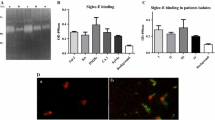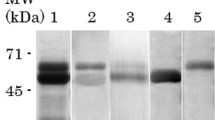Abstract
Attempts to control human malaria by immunological means could be compromised by antigenic variability within and between different strains of malarial parasites1. A useful alternative approach might be to block parasite antigens which are important in the mechanisms of invasion of red cells. As the major human parasite Plasmodium falciparum is highly specific for human red cells, isolation of the proteins involved in the recognition of red cells by this parasite might be of particular value. Recent studies suggest that the major red cell sialoglycoproteins (SGPs), glycophorins A, B and possibly C, may carry the sites recognized by the parasite2–4. Furthermore, because certain carbohydrates present on SGPs such as N-acetylglucosamine are able to block invasion by the parasite5, they may be involved in the initial interaction between parasite and red cell. We have now identified parasite proteins which bind to SGP or N-acetylglucosamine on Sepharose 4B columns. Three proteins, of molecular weights (MWs) 140,000 (140K), 70K and 35K, seem to be specifically bound by N-acetylglucosamine.
Similar content being viewed by others
References
Wilson, R. J. M. Nature 284, 451–452 (1980).
Miller, L. H. et al. J. exp. Med. 146, 277–281 (1977).
Pasvol, G., Wainscoat, J. S. & Weatherall, D. J. Nature 297, 64–66 (1981).
Pasvol, G. et al. Lancet ii, 947–950 (1982).
Weiss, M. M., Oppenheim, J. D. & Vanderberg, J. P. Expl Parasit. 51, 400–407 (1981).
Kilejian, A. Proc. natn. Acad. Sci. U.S.A. 77, 3695–399 (1980).
Perkins, M. J. Cell Biol. 90, 563–657 (1981).
Perrin, L. H. & Dayai, R. Immun. Rev. 61, 245–269 (1982).
Pasvol, G., Wilson, R. J. M., Smalley, M. E. & Brown, J. Ann. trop. Med. Parasit. 72, 87–88 (1978).
Newbold, C. I., Boyle, D. B., Smith, C. C. & Brown, K. N. Molec. Biochem. Parasit. 5(1), 33–44 (1982).
Anstee, D. J. & Tanner, M. J. A. Biochem. J. 138, 381–386 (1974).
Author information
Authors and Affiliations
Rights and permissions
About this article
Cite this article
Jungery, M., Boyle, D., Patel, T. et al. Lectin-like polypeptides of P. falciparum bind to red cell sialoglycoproteins. Nature 301, 704–705 (1983). https://doi.org/10.1038/301704a0
Received:
Accepted:
Issue Date:
DOI: https://doi.org/10.1038/301704a0
- Springer Nature Limited
This article is cited by
-
Lectin-binding sites in the midgut of the mosquitoesAnopheles stephensi Liston andAedes aegypti L. (Diptera: Culicidae)
Parasitology Research (1989)
-
Histochemical study ofSarcocystis sp. intramuscular cysts in gastrocnemius and soleus of the cat
Parasitology Research (1988)
-
Immune sera recognize on erythrocytes a Plasmodium falciparum antigen composed of repeated amino acid sequences
Nature (1984)





